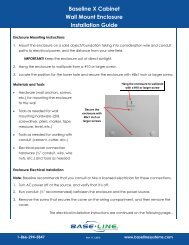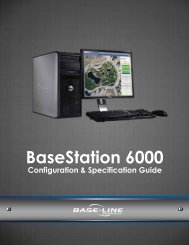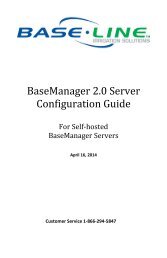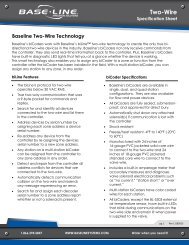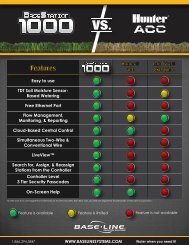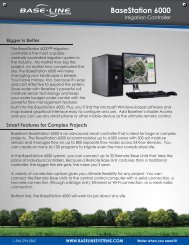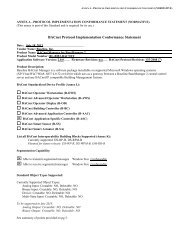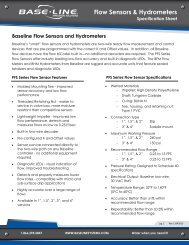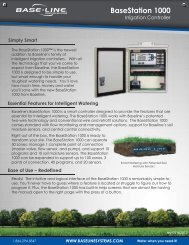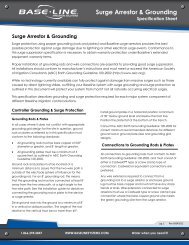BaseStation 3200 User Manual - Baseline Systems
BaseStation 3200 User Manual - Baseline Systems
BaseStation 3200 User Manual - Baseline Systems
You also want an ePaper? Increase the reach of your titles
YUMPU automatically turns print PDFs into web optimized ePapers that Google loves.
C h a p t e r 1 – G e t t i n g S t a r t e dAngling the sensor can profile a deeper soil column for trees that have deeper root structures aswell.If the tree is watered with drip emitters or bubblers, install the sensor in a location that is notdirectly under the emitter or bubbler to avoid partial watering of the whole root zone of the tree.If multiple emitters are used for a single tree, a good rule of thumb is to install the sensor roughlyhalf way between two emitters and as much inside the root mass of the tree as possible withoutdamaging the roots. Root depth and water requirements for trees and shrubs vary much moregreatly than for turf. Consult an experienced Arborist for or MasterGardener for specific guidelines for watering trees.Most trees are watered along with turf in commercial landscapes. In this case, <strong>Baseline</strong>recommends that biSensor(s) be installed for the turf areas, and that the default run time(s) ofzones with trees be adjusted to insure water application to 12” or whatever is required tooptimize tree health.Installing biSensors with New TreesIn the case of new landscape with newly installed trees that are watered separately from turfzones, it is important to make sure that the sensor is located as close to the root ball in the top1/3 of the root ball as possible. Watering new trees with a sensor based watering strategy is agood way of avoiding inadvertently “drowning” new trees and shrubs due to overwatering.Shrubs and Other Ornamental PlantsMany landscapes feature shrub zones that are separately watered from turf zones. Shrubsgenerally have very different water needs from turf, so this is a good thing!For shrub zones, a representative plant should be chosen, and the biSensor should be installed inor close to the top 1/3 of the root zone for the plant, without damaging the root structure of theplant.If drip emitters or bubblers are used, install the sensor in a location that is not directly under theemitter or bubbler to avoid partial watering of the whole root zone of the plant.Gardens and Crop PlantsSensors are excellent tools for maximizing crop results, and have been used for decades inirrigated agriculture.Garden and crop plant watering depends greatly on the type of plants being grown, and isbeyond the scope of this manual.To plan a watering strategy for larger gardens or crops, <strong>Baseline</strong> recommends that you contactyour local Cooperative Extension Office. You can find a national register of the extension officesat: http://www.csrees.usda.gov/Extension/.Page 29<strong>Baseline</strong> <strong>3200</strong>



